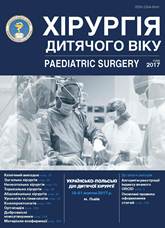Local replacement esophagoplasty in children with esophageal stenosis
DOI:
https://doi.org/10.15574/PS.2017.56.57Keywords:
esophageal stenosis, esophagoplasty, colon patch, segmental colon insert, childrenAbstract
Objective: to evaluate the surgical treatment outcomes of esophageal stenosis using local replacement esophagoplasty in children.Material and methods. From 2004 to 2016 local replacement esophagoplasties were performed in 15 children aged from 3 to 15 years in the pediatric surgery departments of O.O. Bogomolets National Medical University. In 13 children colon patch for esophagoplasty was used and segmental colon insert was used in 2 patients. 12 patients had corrosive esophageal stenosis and the rest 3 children had peptic stenosis.
Results and discussion. The treatment outcomes analysis of 13 cases showed a smooth postoperative period. In 2 patients there was a need for preventive balloon dilation of the postoperative zone during the period from 1 to 6 months. During the long-term follow-up, which was from 1 to 13 years, in 12 of 13 children who were operated using colon patch the epithelization of stenotic zone and absence of its inflammatory changes was noted. In one case the resection of pseudodiverticulum of the colon transplant was performed 36 months after esophagoplasty with the good postoperative results. In one child with colon patch and in one child with segmental colon insert the postoperative stenosis as result of anastomotic leakage was formed and required the total esophageal replacement after 9-12 months.
Conclusions: Local replacement esophagoplasty is an effective surgical method for treatment of esophageal stenosis in children. Indications for these operations are local esophageal stenosis, which cannot be successfully treated using conservative and instrumental methods along with the preserved function of the upper and lower esophageal sphincters The privilege should be given to the colon patch esophagoplasty due to the preservation of metasympathetic esophageal innervation and the possibility of epithelization of the stenotic area in the long-term period.
References
Ashcraft KW, Holder TM. (1996). Pediatric Surgery. Saint-Petersburg: Hardford, 1: 384.
Alaa F Hamza, Sameh Abdelhay, Hatem Sherif et al. (2003). Caustic esophageal strictures in children: 30 years’ experience. J Pediatr Surgery. 38: 828-833.
Kennedy AP, Cameron BH, McGill CW. (1995). Colon-patch esophagoplasty for caustic esophageal stricture. J Pediatr Surgery. 30: 1242-1245.
Coopman S, Michaud L, Halna-Tamine M et al. (2008). Long-term Outcome of Colon Interposition After Esophagectomy in Children. J Pediatr Gastroenterology & Nutrition. 47: 458–462.
Luoma R, Raboei E. (2000). Colon-patch oesophagoplasty. Eur J Pediatr Surg. 10: 194-196.
Othersen HB, Smith CD. (1986). Colon-Patch esophagoplasty in children: an alternative to esophageal replacement. J Pediatr Surgery. 21: 412-417.
Raboei EH, Luoma R. (2008). Colon Patch Esophagoplasty: An Alternative to Total Esophagus Replacement? Eur J Pediatr Surg. 18: 1-3.
Othersen HB, Parker EF, Chendler J et al. (1997). Save the child’s esophаgus, part 2: Colic-Patch repair. J Pediatr Surgery. 32: 328-333.
Downloads
Issue
Section
License
The policy of the Journal “PAEDIATRIC SURGERY. UKRAINE” is compatible with the vast majority of funders' of open access and self-archiving policies. The journal provides immediate open access route being convinced that everyone – not only scientists - can benefit from research results, and publishes articles exclusively under open access distribution, with a Creative Commons Attribution-Noncommercial 4.0 international license(СС BY-NC).
Authors transfer the copyright to the Journal “PAEDIATRIC SURGERY.UKRAINE” when the manuscript is accepted for publication. Authors declare that this manuscript has not been published nor is under simultaneous consideration for publication elsewhere. After publication, the articles become freely available on-line to the public.
Readers have the right to use, distribute, and reproduce articles in any medium, provided the articles and the journal are properly cited.
The use of published materials for commercial purposes is strongly prohibited.

